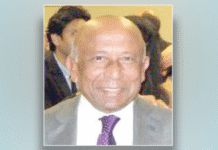By
Those who believe the West is experiencing a form of imperial decline cite familiar reasons – eroding military budgets, the growing assertiveness of China and Russia, etc. John Rapley, however, points to another cause. He attributes the West’s decline to capital flows making their way to emerging markets.
By John Rapley*
Since the turn of the millennium, a significant new trend has emerged in global politics. After decades in which talk of the relative decline of the West was belied by the facts, it seems now to have genuinely begun. The collective economic output of the developed OECD countries, for example, has begun to slide relative to the rest of the world. Overall, these countries’ combined share of global GDP has fallen by a quarter. Trailing in its wake is a similar decline in their share of global military expenditure. While fiscal austerity erodes Western military budgets, China and Russia are spending liberally and growing more assertive. Meanwhile, the multiplication of fronts on which asymmetric warfare takes place is challenging all governments to respond to these threats decisively.
None of this should surprise us. On the contrary, the only surprising thing is that anyone should have been caught off guard by it. After all, no empire has yet found a way to maintain its dominance indefinitely. Instead, empires tend to follow a well-worn path of rise, peak and decline, with the only exceptional thing about the Western experience being the character of its decline. As in most stages of imperial decline, the economic centre has shifted away from the traditional ‘core’ and towards the ‘periphery.’ Unlike previous cases, however, the shift is most visible in terms of capital flows and the returns on capital, which are now much higher in emerging markets than in the OECD countries.
The great divergence
Colonizing foreign lands typically involves organising production in such a way as to create a net transfer of wealth from the colonies to the imperial heartland. The crudest form of this is outright plunder, but there is no inherent need for imperial expansion to bring about absolute economic contraction in the periphery. In fact, it may lead to growth in the colonies. When it does, the empire’s defenders may use this as evidence that imperial powers have a civilising mission, an important theme in the literature on empires that recurs throughout history. Typically, however, the heartland grows faster than the colonies, as the net flow of aggregate imperial production favours the dominant power.
For example, although per capita incomes grew in both Western Europe and the European colonies during the high age of European imperialism in the nineteenth and early twentieth centuries, the ratio of per capita incomes widened. In 1800, per capita incomes in Europe and the colonies were roughly level, with a ratio of around 3:1 – i.e., the average person in Europe or its former white dominions (the US, Canada, Australia and New Zealand) earned three times what the average person in the colonies did. By the mid-twentieth century, this ratio had widened tenfold, to about to 30:1.
Of course, a great wave of decolonisation brought an end to the British and French Empires after the Second World War. But while independence was meant to reverse this ‘great divergence’ (as it came to be known), it initially only accelerated the relative rise of the West. By the end of the 20th century, that ratio of 30:1 had doubled. In fact, one could make a case that the high water mark of Western empire actually came in this post-World War II period, and that the formal dissolution of empires strengthened the West as a whole – which now functioned with a high degree of cohesion.
Americans tend to recoil at the suggestion that they ever had any kind of an empire, beyond a few relatively short-lived colonies in the Pacific and Caribbean. As proof, they cite America’s resistance to Britain’s and France’s efforts to reconstitute their empires after the Second World War. But the suggestion that America was an anti-imperial hegemon rests on a narrow conception of imperialism that is at odds with the historical experience. Washington may not have run the daily affairs of the newly-independent states; but then again, neither do most empires in their colonies. Looking at the Roman Empire, for instance, the communications and logistical challenges of an age in which goods and soldiers moved overland at the speed of a cart made it impossible for Rome to maintain direct control over its outlying regions. Instead, the Roman nobility was drawn together into an ideologically cohesive vision of empire – what the historian Peter Heather has called ‘Latin, towns and togas.’ The structures, legal framework and ideology of empire emanated from Rome, but day-to-day administration was left in the hands of the nobility and a ring of client-states.
Broadly speaking, there are important similarities between this imperial model and the pattern which emerged in the post-World War II period. United by a shared democratic ideology, a series of international institutions bound together a US-dominated alliance: the United Nations, the World Bank and International Monetary Fund, NATO, GATT, the OECD, the G7. Whether by design or simply as a result of the advantages that accrue to dominant powers, the net resource transfer that had been formally organized during the period of European imperialism continued via these informal structures. The global trading regime continued to favor industrial over primary producers, extending the bias against ‘developing’ countries. Meanwhile, as the new Third-World governments engaged in the slow and laborious task of building their own bureaucracies and the education systems that would staff them, their role in international trade negotiations tended towards the passive. Moreover, the global currency system, which encouraged countries to hold foreign reserves in US dollars, allowed a massive buildup of Third-World assets in Western banks. That helped keep the cost of capital in the major economies comparatively cheap.
Finally, the global state system, which was grounded in the Western model of the sovereign nation-state, enforced a system of migration control that limited the movement of people from the periphery towards the core, where incomes were higher. Mass migrations, of course, are a recurring feature of world history. Indeed, it was the movement of peoples from the periphery of the Roman Empire into its heartland, which we know as the barbarian invasions, that ultimately undermined the Roman Empire’s fiscal base, leading to its collapse. In the post-war period, by contrast, national barriers to migration, policed by newly-independent states through the regime of passports and immigration officers, interrupted the flow of populations and built up pressure in the periphery. Bottled up in their homelands, a tide of humanity filled the young cities of newly-independent states at an unprecedented rate. The result was a sort of global-scale apartheid, in which immigration control limited job competition and inflated wages in the ‘white suburbs’ of the West.
The course of empire?
The post-war global system resembled a US-dominated economic empire in which independent states perpetuated a framework that disproportionately benefited the West. Again, this is not unlike the Roman Empire in its final decades, when it maintained its hegemony through client-states. Interestingly, while the conventional wisdom is that the Roman Empire had been in terminal decline for centuries, historians now know that its aggregate output actually peaked during this final period. Earlier historians were misled by the evident decline of the economy of Rome itself, but this would be akin to seeing Britain’s twentieth-century decline relative to the US as evidence that the West was in a terminal phase. In the Roman case, the heartland of empire had simply radiated outwards from its birthplace towards its provinces, which ultimately surpassed the mother country.
This outward radiation from the core to the periphery may be the same logic that is operating against the West today. In its constant search for cheaper supplies and labour, the centre of the global economy is moving towards the erstwhile periphery. Restrictions on labour mobility retarded this process temporarily, but tectonic changes in the global economy overwhelmed even these controls. Changes in transportation technology, like containerization, slashed the cost of shipping. Miniaturisation, the substitution of plastics for metals, and the increasing share of knowledge in products reduced the weight of output, further reducing the need for manufacturers to locate close to their markets. New management technologies thinned administration and substituted networks of autonomous producers for large, hierarchical firms, enabling firms to break up the production process and outsource labour-intensive components to low-wage zones. Finally, when policy regimes lifted controls on capital markets and trade in the late twentieth century, the barriers to capital mobility were largely lifted. Attila no longer needed to sack Rome. The new Rome was shipping its capital to the former colonies.
This tendency began in the late twentieth century, but cyclical features muted its effects until around the turn of the millennium. Then, after two centuries in which the net flow of capital had moved from core to periphery, the direction of global flows reversed. Today, net global investment flows have shifted towards emerging markets. China leads the way, but it is not the only country benefiting from the mobility of global capital. According to World Bank figures, the continental which grew fastest in 2014 was Africa.
The simple fact is that returns on capital are now much higher in the periphery than in the core, which means that the center of the global economy is in the process of relocating. Compared to the Roman case, this time it is capital rather than labour that has overwhelmed imperial defenses. As it did in antiquity, this shift will manifest itself in the slowly eroding fiscal position of core states. The US may remain the world’s dominant economy for the foreseeable future, but, together with its allies, it will be forced to negotiate a world very different from that of the last two centuries.
*John Rapley is a writer and academic based in London, and author of The Money Cult: The Priests, Prophets and Magicians of Economic History (Simon and Schuster, 2016).
Source: Eurasiareview











An eye opener to many facts we didn’t know.